Optimizing the Atmospheric CO2 Retrieval Based on the NDACC-Type FTIR Mid-Infrared Spectra at Xianghe, China
Abstract
1. Introduction
2. Materials and Methods
2.1. Measurement Site
2.2. FTIR Measurement
2.3. NDACC Retrieval Strategy
2.4. Reference Datasets and Comparison Methods
2.4.1. TCCON
2.4.2. CAMS Global Greenhouse Gas Reanalysis (EGG4)
3. Results
3.1. Sensitivity Studies
3.1.1. Impact from the Type of Spectra and Spectroscopy
3.1.2. Impact from Line List Parameters
3.2. Comparison with TCCON Measurements
3.3. Comparison with CAMS Model
4. Conclusions
Author Contributions
Funding
Data Availability Statement
Acknowledgments
Conflicts of Interest
Appendix A
| Spectroscopy | Wavenumber cm−1 | Line Intensity cm−1/(Molecule cm−2) | γair | γself | Uncertainty | ||
|---|---|---|---|---|---|---|---|
| Line Intensity | γair | γself | |||||
| ATM18 | 2620.835313 | 3.195 × 10−25 | 0.0828 | 0.1100 | [1%, 2%) | [1%, 2%) | [1%, 2%) |
| ATM20 | 2620.835313 | 3.195 × 10−25 | 0.0828 | 0.1100 | [1%, 2%) | [1%, 2%) | [1%, 2%) |
| HITRAN2016 | 2620.835313 | 3.195 × 10−25 | 0.0828 | 0.110 | [1%, 2%) | [1%, 2%) | [1%, 2%) |
| HITRAN2020 | 2620.835318 | 3.195 × 10−25 | 0.0801 | 0.109 | [1%, 2%) | [2%, 5%) | [2%, 5%) |
| ATM18 | 2626.629861 | 4.210 × 10−25 | 0.0745 | 0.1010 | [1%, 2%) | [1%, 2%) | [1%, 2%) |
| ATM20 | 2626.629861 | 4.210 × 10−25 | 0.0745 | 0.1010 | [1%, 2%) | [1%, 2%) | [1%, 2%) |
| HITRAN2016 | 2626.629861 | 4.210 × 10−25 | 0.0745 | 0.101 | [1%, 2%) | [1%, 2%) | [1%, 2%) |
| HITRAN2020 | 2626.629869 | 4.210 × 10−25 | 0.0740 | 0.100 | [1%, 2%) | [2%, 5%) | [2%, 5%) |
| ATM18 | 2627.350141 | 4.193 × 10−25 | 0.0737 | 0.1010 | [1%, 2%) | [1%, 2%) | [1%, 2%) |
| ATM20 | 2627.350100 | 4.193 × 10−25 | 0.0737 | 0.1010 | [1%, 2%) | [1%, 2%) | [1%, 2%) |
| HITRAN2016 | 2627.350141 | 4.193 × 10−25 | 0.0737 | 0.101 | [1%, 2%) | [1%, 2%) | [1%, 2%) |
| HITRAN2020 | 2627.350149 | 4.193 × 10−25 | 0.0735 | 0.099 | [1%, 2%) | [2%, 5%) | [2%, 5%) |
| ATM18 | 2629.505616 | 3.983 × 10−25 | 0.0717 | 0.0980 | [1%, 2%) | [1%, 2%) | [1%, 2%) |
| ATM20 | 2629.505616 | 3.983 × 10−25 | 0.0717 | 0.0980 | [1%, 2%) | [1%, 2%) | [1%, 2%) |
| HITRAN2016 | 2629.505616 | 3.983 × 10−25 | 0.0717 | 0.098 | [1%, 2%) | [1%, 2%) | [1%, 2%) |
| HITRAN2020 | 2629.505627 | 3.983 × 10−25 | 0.0720 | 0.096 | [1%, 2%) | [2%, 5%) | [2%, 5%) |
| ATM18 | 4790.125762 | 9.871 × 10−24 | 0.0722 | 0.0990 | [1%, 2%) | [1%, 2%) | [1%, 2%) |
| ATM20 | 4790.125762 | 9.871 × 10−24 | 0.0722 | 0.0990 | [1%, 2%) | [1%, 2%) | [1%, 2%) |
| HITRAN2016 | 4790.125762 | 9.871 × 10−24 | 0.0722 | 0.099 | [1%, 2%) | [1%, 2%) | [1%, 2%) |
| HITRAN2020 | 4790.125755 | 9.960 × 10−24 | 0.0720 | 0.096 | [1%, 2%) | [2%, 5%) | [2%, 5%) |
| ATM18 | 4791.892568 | 1.037 × 10−23 | 0.0735 | 0.1000 | [1%, 2%) | [1%, 2%) | [1%, 2%) |
| ATM20 | 4791.892568 | 1.037 × 10−23 | 0.0735 | 0.1000 | [1%, 2%) | [1%, 2%) | [1%, 2%) |
| HITRAN2016 | 4791.892568 | 1.037 × 10−23 | 0.0735 | 0.100 | [1%, 2%) | [1%, 2%) | [1%, 2%) |
| HITRAN2020 | 4791.892560 | 1.048 × 10−23 | 0.0730 | 0.098 | [2%, 5%) | [2%, 5%) | [2%, 5%) |
| ATM18 | 4795.369262 | 1.060 × 10−23 | 0.0769 | 0.1040 | [1%, 2%) | [1%, 2%) | [1%, 2%) |
| ATM20 | 4795.369262 | 1.060 × 10−23 | 0.0769 | 0.1040 | [1%, 2%) | [1%, 2%) | [1%, 2%) |
| HITRAN2016 | 4795.369262 | 1.060 × 10−23 | 0.0769 | 0.104 | [1%, 2%) | [1%, 2%) | [1%, 2%) |
| HITRAN2020 | 4795.369248 | 1.074 × 10−23 | 0.0752 | 0.102 | [1%, 2%) | [2%, 5%) | [2%, 5%) |
| ATM18 | 4798.064346 | 1.093 × 10−23 | 0.0800 | 0.1070 | [1%, 2%) | [1%, 2%) | [1%, 2%) |
| ATM20 | 4798.064346 | 1.093 × 10−23 | 0.0800 | 0.1070 | [1%, 2%) | [1%, 2%) | [1%, 2%) |
| HITRAN2016 | 4798.064346 | 1.093 × 10−23 | 0.0800 | 0.107 | [1%, 2%) | [1%, 2%) | [1%, 2%) |
| HITRAN2020 | 4798.064294 | 1.093 × 10−23 | 0.0774 | 0.105 | [2%, 5%) | [2%, 5%) | [2%, 5%) |
References
- Friedlingstein, P.; Jones, M.W.; O’Sullivan, M.; Andrew, R.M.; Bakker, D.C.E.; Hauck, J.; Le Quéré, C.; Peters, G.P.; Peters, W.; Pongratz, J.; et al. Global Carbon Budget 2021. Earth Syst. Sci. Data 2022, 14, 1917–2005. [Google Scholar] [CrossRef]
- Lan, X.; Tans, P.; Thoning, K.W. Trends in globally-averaged CO2 determined from NOAA Global Monitoring Laboratory measurements. Version 2023-04. Available online: https://gml.noaa.gov/ccgg/trends/global.html?doi=10.15138/9n0h-zh07 (accessed on 5 July 2023).
- IPCC. Climate Change 2022: Impacts, Adaptation, and Vulnerability. Contribution of Working Group II to the Sixth Assessment Report of the Intergovernmental Panel on Climate Change; Cambridge University Press: Cambridge, UK; New York, NY, USA, 2022; 3056p. [Google Scholar] [CrossRef]
- Schimel, D.; Stephens, B.B.; Fisher, J.B. Effect of increasing CO2 on the terrestrial carbon cycle. Proc. Natl. Acad. Sci. USA 2015, 112, 436–441. [Google Scholar] [CrossRef]
- Messerschmidt, J.; Parazoo, N.; Wunch, D.; Deutscher, N.M.; Roehl, C.; Warneke, T.; Wennberg, P.O. Evaluation of seasonal atmosphere–biosphere exchange estimations with TCCON measurements. Atmos. Chem. Phys. 2013, 13, 5103–5115. [Google Scholar] [CrossRef]
- Velazco, V.A.; Deutscher, N.M.; Morino, I.; Uchino, O.; Bukosa, B.; Ajiro, M.; Kamei, A.; Jones, N.B.; Paton-Walsh, C.; Griffith, D.W.T. Satellite and ground-based measurements of XCO2 in a remote semiarid region of Australia. Earth Syst. Sci. Data 2019, 11, 935–946. [Google Scholar] [CrossRef]
- Yang, D.; Boesch, H.; Liu, Y.; Somkuti, P.; Cai, Z.; Chen, X.; Di Noia, A.; Lin, C.; Lu, N.; Lyu, D.; et al. Toward high precision XCO2 retrievals from TanSat observations: Retrieval improvement and validation against TCCON measurements. J. Geophys. Res. 2020, 125, 032794. [Google Scholar] [CrossRef] [PubMed]
- Zhou, M.; Ni, Q.; Cai, Z.; Langerock, B.; Nan, W.; Yang, Y.; Che, K.; Yang, D.; Wang, T.; Liu, Y.; et al. CO2 in Beijing and Xianghe Observed by Ground-Based FTIR Column Measurements and Validation to OCO-2/3 Satellite Observations. Remote Sens. 2022, 14, 3769. [Google Scholar] [CrossRef]
- De Mazière, M.; Thompson, A.M.; Kurylo, M.J.; Wild, J.D.; Bernhard, G.; Blumenstock, T.; Braathen, G.O.; Hannigan, J.W.; Lambert, J.-C.; Leblanc, T.; et al. The Network for the Detection of Atmospheric Composition Change (NDACC): History, status and perspectives. Atmos. Chem. Phys. 2018, 18, 4935–4964. [Google Scholar] [CrossRef]
- Barthlott, S.; Schneider, M.; Hase, F.; Wiegele, A.; Christner, E.; González, Y.; Blumenstock, T.; Dohe, S.; García, O.E.; Sepúlveda, E.; et al. Using XCO2 retrievals for assessing the long-term consistency of NDACC/FTIR data sets. Atmos. Meas. Tech. 2015, 8, 1555–1573. [Google Scholar] [CrossRef]
- Buschmann, M.; Deutscher, N.M.; Sherlock, V.; Palm, M.; Warneke, T.; Notholt, J. Retrieval of xCO2 from ground-based mid-infrared (NDACC) solar absorption spectra and comparison to TCCON. Atmos. Meas. Tech. 2016, 9, 577–585. [Google Scholar] [CrossRef]
- Chiarella, R.; Buschmann, M.; Laughner, J.; Morino, I.; Notholt, J.; Petri, C.; Toon, G.; Velazco, V.A.; Warneke, T. A retrieval of XCO2 from ground-based mid-infrared NDACC solar absorption spectra and comparison to TCCON. Atmos. Meas. Tech. 2023, 16, 3987–4007. [Google Scholar] [CrossRef]
- Shan, C.; Wang, W.; Xie, Y.; Wu, P.; Xu, J.; Zeng, X.; Zha, L.; Zhu, Q.; Sun, Y.; Hu, Q.; et al. Observations of atmospheric CO2 and CO based on in-situ and ground-based remote sensing measurements at Hefei site, China. Sci. Total Environ. 2022, 851, 158188. [Google Scholar] [CrossRef] [PubMed]
- Yang, Y.; Zhou, M.; Wang, T.; Yao, B.; Han, P.; Ji, D.; Zhou, W.; Sun, Y.; Wang, G.; Wang, P. Spatial and temporal variations of CO2 mole fractions observed at Beijing, Xianghe, and Xinglong in North China. Atmos. Chem. Phys. 2021, 21, 11741–11757. [Google Scholar] [CrossRef]
- Yang, Y.; Zhou, M.; Langerock, B.; Sha, M.K.; Hermans, C.; Wang, T.; Ji, D.; Vigouroux, C.; Kumps, N.; Wang, G.; et al. New ground-based Fourier-transform near-infrared solar absorption measurements of XCO2, XCH4 and XCO at Xianghe, China. Earth Syst. Sci. Data 2020, 12, 1679–1696. [Google Scholar] [CrossRef]
- Ji, D.; Zhou, M.; Wang, P.; Yang, Y.; Wang, T.; Sun, X.; Hermans, C.; Yao, B.; Wang, G. Deriving temporal and vertical distributions of methane in Xianghe using ground-based Fourier transform infrared and gas-analyzer measurements. Adv. Atmos. Sci. 2020, 37, 597–607. [Google Scholar] [CrossRef]
- Zhou, M.; Langerock, B.; Vigouroux, C.; Dils, B.; Hermans, C.; Kumps, N.; Nan, W.; Metzger, J.-M.; Mahieu, E.; Wang, T.; et al. Tropospheric and stratospheric NO retrieved from ground-based Fourier-transform infrared (FTIR) measurements. Atmos. Meas. Tech. 2021, 14, 6233–6247. [Google Scholar] [CrossRef]
- Blumenstock, T.; Hase, F.; Keens, A.; Czurlok, D.; Colebatch, O.; Garcia, O.; Griffith, D.W.T.; Grutter, M.; Hannigan, J.W.; Heikkinen, P.; et al. Characterization and potential for reducing optical resonances in Fourier transform infrared spectrometers of the Network for the Detection of Atmospheric Composition Change (NDACC). Atmos. Meas. Tech. 2021, 14, 1239–1252. [Google Scholar] [CrossRef]
- Gordon, I.E.; Rothman, L.S.; Hargreaves, R.J.; Hashemi, R.; Karlovets, E.V.; Skinner, F.M.; Conway, E.K.; Hill, C.; Kochanov, R.V.; Tan, Y.; et al. The HITRAN2020 molecular spectroscopic database. J. Quant. Spectrosc. Radiat. Transf. 2022, 277, 107949. [Google Scholar] [CrossRef]
- Toth, R.A.; Brown, L.R.; Miller, C.E.; Devi, V.M.; Benner, D.C. Spectroscopic database of CO2 line parameters: 4300–7000 cm−1. J. Quant. Spectrosc. Radiat. Transf. 2008, 109, 906–921. [Google Scholar] [CrossRef]
- Rodgers, C.D. Inverse methods for atmospheric sounding—Theory and Practice, Series on Atmospheric Oceanic and Planetary Physics; World Scientific: Singapore, 2000; Volume 2, p. 256. [Google Scholar] [CrossRef]
- Tihonov, A.N. Solution of incorrectly formulated problems and the regularization method. Soviet Math. Dokl. 1963, 4, 1035–1038. [Google Scholar]
- Zhou, M.; Langerock, B.; Sha, M.K.; Kumps, N.; Hermans, C.; Petri, C.; Warneke, T.; Chen, H.; Metzger, J.-M.; Kivi, R.; et al. Retrieval of atmospheric CH4 vertical information from ground-based FTS near-infrared spectra. Atmos. Meas. Tech. 2019, 12, 6125–6141. [Google Scholar] [CrossRef]
- Shan, C.; Wang, W.; Liu, C.; Guo, Y.; Xie, Y.; Sun, Y.; Hu, Q.; Zhang, H.; Yin, H.; Jones, N. Retrieval of vertical profiles and tropospheric CO2 columns based on high-resolution FTIR over Hefei, China. Opt. Express 2021, 29, 4958–4977. [Google Scholar] [CrossRef] [PubMed]
- Buschmann, M.; Deutscher, N.M.; Palm, M.; Warneke, T.; Weinzierl, C.; Notholt, J. The arctic seasonal cycle of total column CO2 and CH4 from ground-based solar and lunar FTIR absorption spectrometry. Atmos. Meas. Tech. 2017, 10, 2397–2411. [Google Scholar] [CrossRef]
- Wunch, D.; Toon, G.C.; Blavier, J.-F.L.; Washenfelder, R.A.; Notholt, J.; Connor, B.J.; Griffith, D.W.T.; Sherlock, V.; Wennberg, P.O. The Total Carbon Column Observing Network. Phil Trans. R. Soc. A 2011, 369, 2087–2112. [Google Scholar] [CrossRef]
- Sun, Y.; Liu, C.; Palm, M.; Vigouroux, C.; Notholt, J.; Hu, Q.; Jones, N.; Wang, W.; Su, W.; Zhang, W.; et al. Ozone seasonal evolution and photochemical production regime in the polluted troposphere in eastern China derived from high-resolution Fourier transform spectrometry (FTS) observations. Atmos. Chem. Phys. 2018, 18, 14569–14583. [Google Scholar] [CrossRef]
- Zhou, M.; Wang, P.; Kumps, N.; Hermans, C.; Nan, W. TCCON Data from Xianghe, China, Release GGG2020.R0 [Data Set]. CaltechDATA. 2022. Available online: https://data.caltech.edu/records/6ywxa-yk431 (accessed on 13 June 2023).
- Laughner, J.L.; Toon, G.C.; Mendonca, J.; Petri, C.; Roche, S.; Wunch, D.; Blavier, J.-F.; Griffith, D.W.T.; Heikkinen, P.; Keeling, R.F.; et al. The Total Carbon Column Observing Network’s GGG2020 Data Version. Earth Syst. Sci. Data Discuss. 2023; in preprint. [Google Scholar] [CrossRef]
- Wunch, D.; Wennberg, P.O.; Toon, G.C.; Connor, B.J.; Fisher, B.; Osterman, G.B.; Frankenberg, C.; Mandrake, L.; O’Dell, C.; Ahonen, P.; et al. A method for evaluating bias in global measurements of CO2 total columns from space. Atmos. Chem. Phys. 2011, 11, 12317–12337. [Google Scholar] [CrossRef]
- Deutscher, N.M.; Griffith, D.W.T.; Bryant, G.W.; Wennberg, P.O.; Toon, G.C.; Washenfelder, R.A.; Keppel-Aleks, G.; Wunch, D.; Yavin, Y.; Allen, N.T.; et al. Total column CO2 measurements at Darwin, Australia—Site description and calibration against in situ aircraft profiles. Atmos. Meas. Tech. 2010, 3, 947–958. [Google Scholar] [CrossRef]
- Rodgers, C.D.; Connor, B.J. Intercomparison of remote sounding instruments. J. Geophys. Res. Atmos. 2003, 108, 4116. [Google Scholar] [CrossRef]
- Zhou, M.; Wang, P.; Langerock, B.; Vigouroux, C.; Hermans, C.; Kumps, N.; Wang, T.; Yang, Y.; Ji, D.; Ran, L.; et al. Ground-based Fourier transform infrared (FTIR) O3 retrievals from the 3040 cm−1 spectral range at Xianghe, China. Atmos. Meas. Tech. 2020, 13, 5379–5394. [Google Scholar] [CrossRef]
- Agustí-Panareda, A.; Barré, J.; Massart, S.; Inness, A.; Aben, I.; Ades, M.; Baier, B.C.; Balsamo, G.; Borsdorff, T.; Bousserez, N.; et al. Technical note: The CAMS greenhouse gas reanalysis from 2003 to 2020. Atmos. Chem. Phys. 2023, 23, 3829–3859. [Google Scholar] [CrossRef]
- Zhou, M.; Langerock, B.; Vigouroux, C.; Sha, M.K.; Ramonet, M.; Delmotte, M.; Mahieu, E.; Bader, W.; Hermans, C.; Kumps, N.; et al. Atmospheric CO and CH4 time series and seasonal variations on Reunion Island from ground-based in situ and FTIR (NDACC and TCCON) measurements. Atmos. Chem. Phys. 2018, 18, 13881–13901. [Google Scholar] [CrossRef]
- Virolainen, Y.A. Methodical aspects of the determination of carbon dioxide in atmosphere using FTIR spectroscopy. J. Appl. Spectrosc. 2018, 85, 462–469. [Google Scholar] [CrossRef]
- Chesnokova, T.Y.; Makarova, M.V.; Chentsov, A.V.; Kostsov, V.S.; Poberovskii, A.V.; Zakharov, V.I.; Rokotyan, N.V. Estimation of the impact of differences in the CH4 absorption line parameters on the accuracy of methane atmospheric total column retrievals from ground-based FTIR spectra. J. Quant. Spectrosc. Radiat. Transf. 2020, 254, 107187. [Google Scholar] [CrossRef]
- Baylon, J.L.; Stremme, W.; Grutter, M.; Hase, F.; Blumenstock, T. Background CO2 levels and error analysis from ground-based solar absorption IR measurements in central Mexico. Atmos. Meas. Tech. 2017, 10, 2425–2434. [Google Scholar] [CrossRef]
- García, O.E.; Schneider, M.; Sepúlveda, E.; Hase, F.; Blumenstock, T.; Cuevas, E.; Ramos, R.; Gross, J.; Barthlott, S.; Röhling, A.N.; et al. Twenty years of ground-based NDACC FTIR spectrometry at Izaña Observatory—Overview and long-term comparison to other techniques. Atmos. Chem. Phys. 2021, 21, 15519–15554. [Google Scholar] [CrossRef]
- Wunch, D.; Wennberg, P.O.; Messerschmidt, J.; Parazoo, N.C.; Toon, G.C.; Deutscher, N.M.; Keppel-Aleks, G.; Roehl, C.M.; Randerson, J.T.; Warneke, T.; et al. The covariation of Northern Hemisphere summertime CO2 with surface temperature in boreal regions. Atmos. Chem. Phys. 2013, 13, 9447–9459. [Google Scholar] [CrossRef]
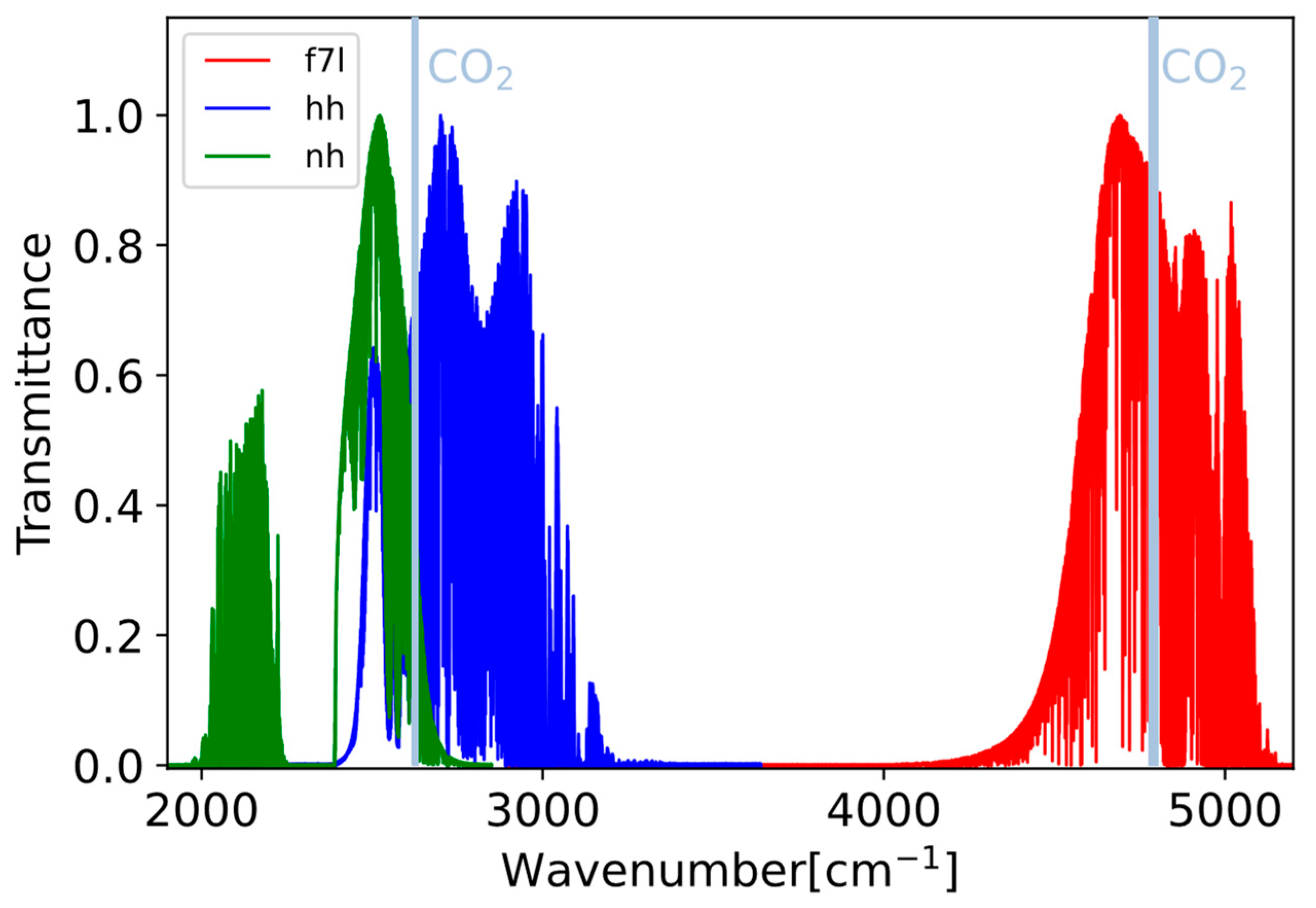
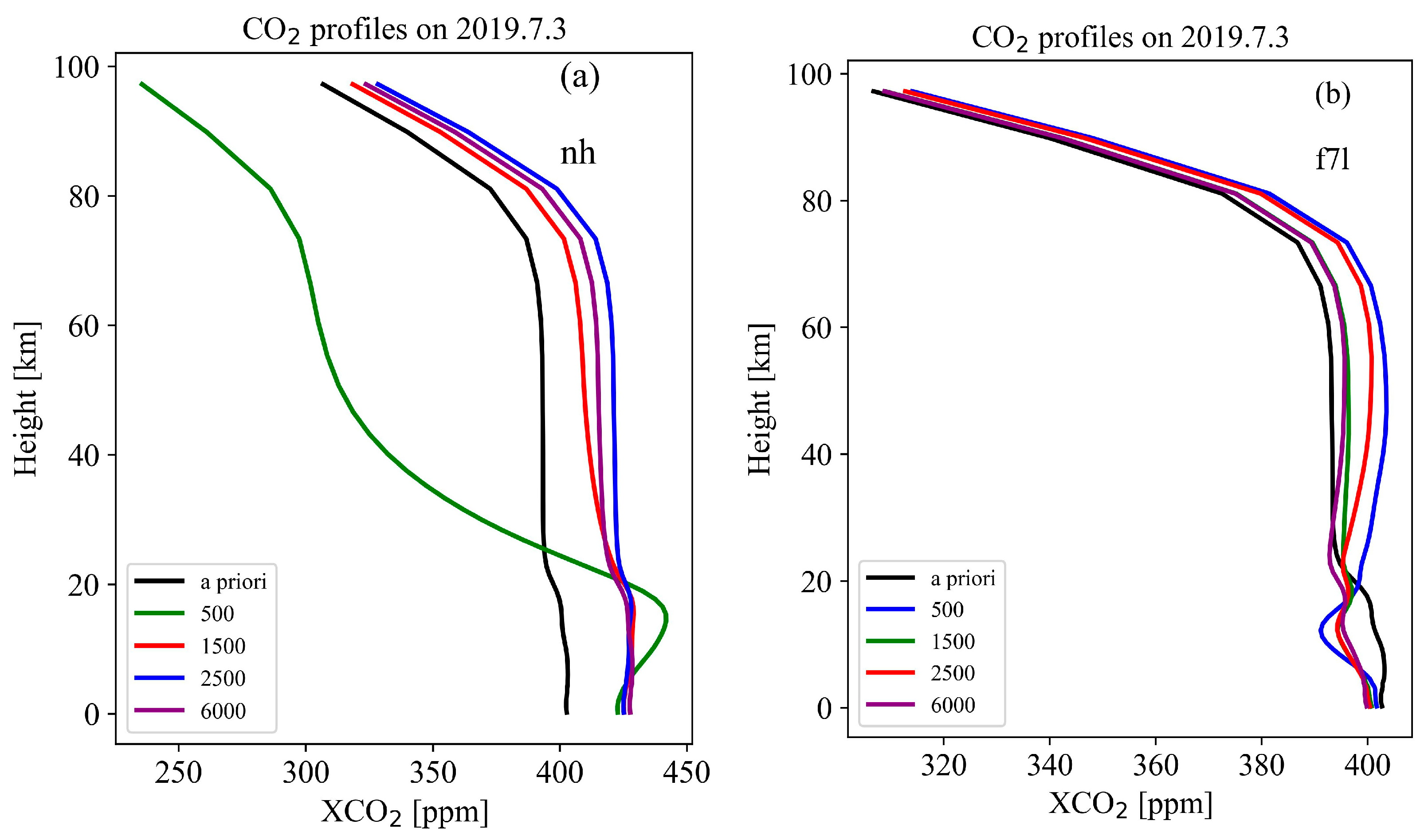
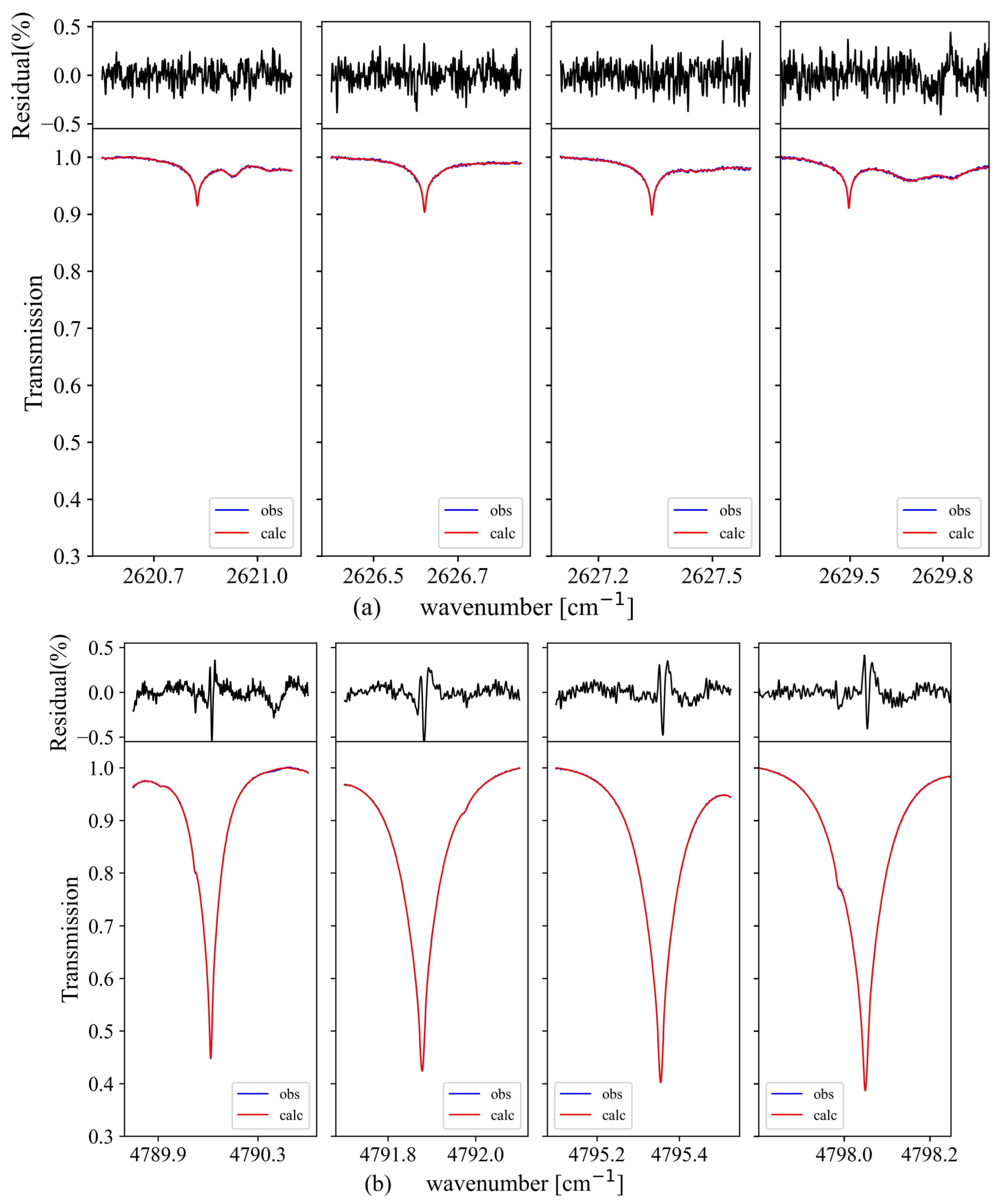
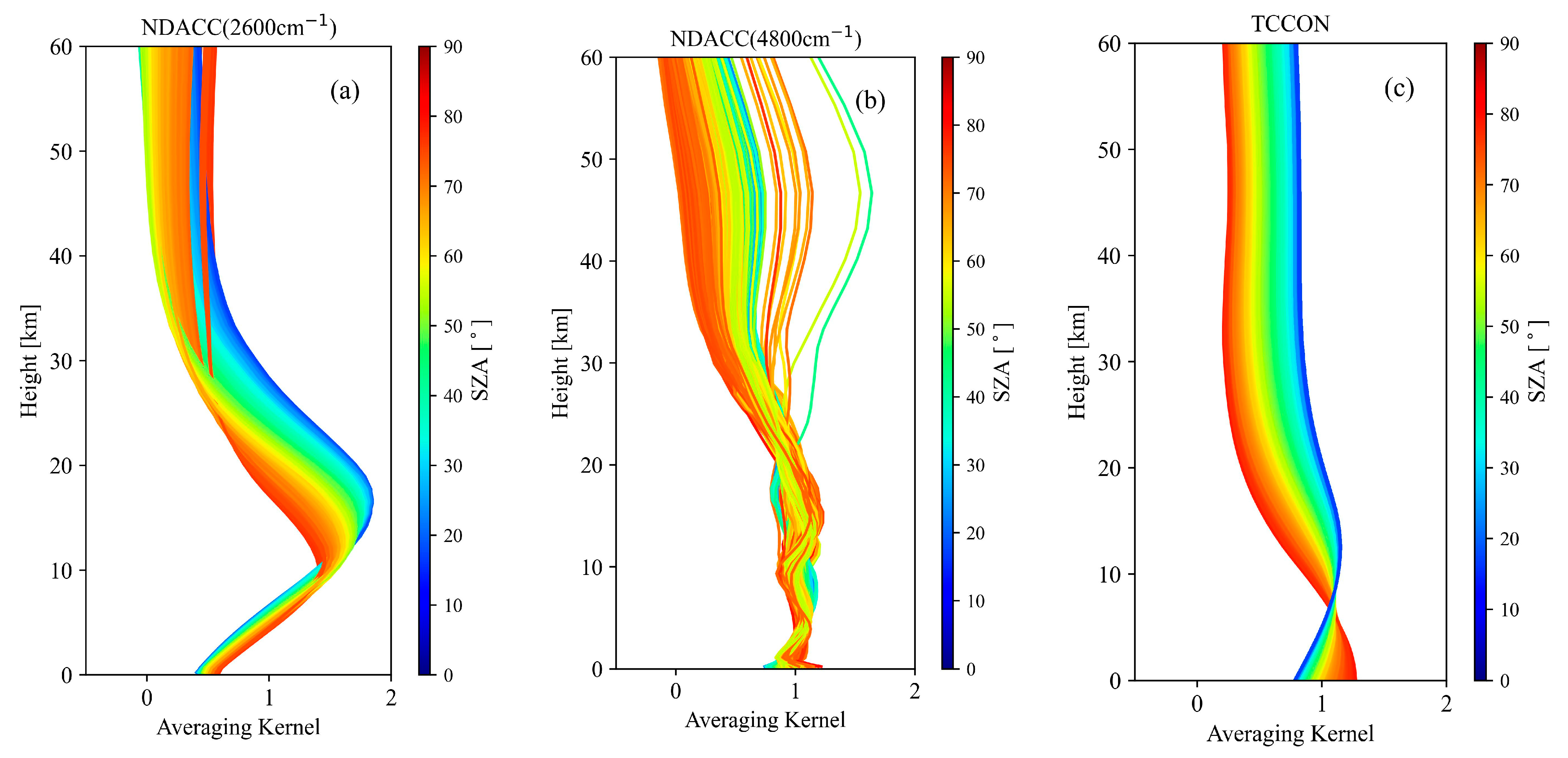
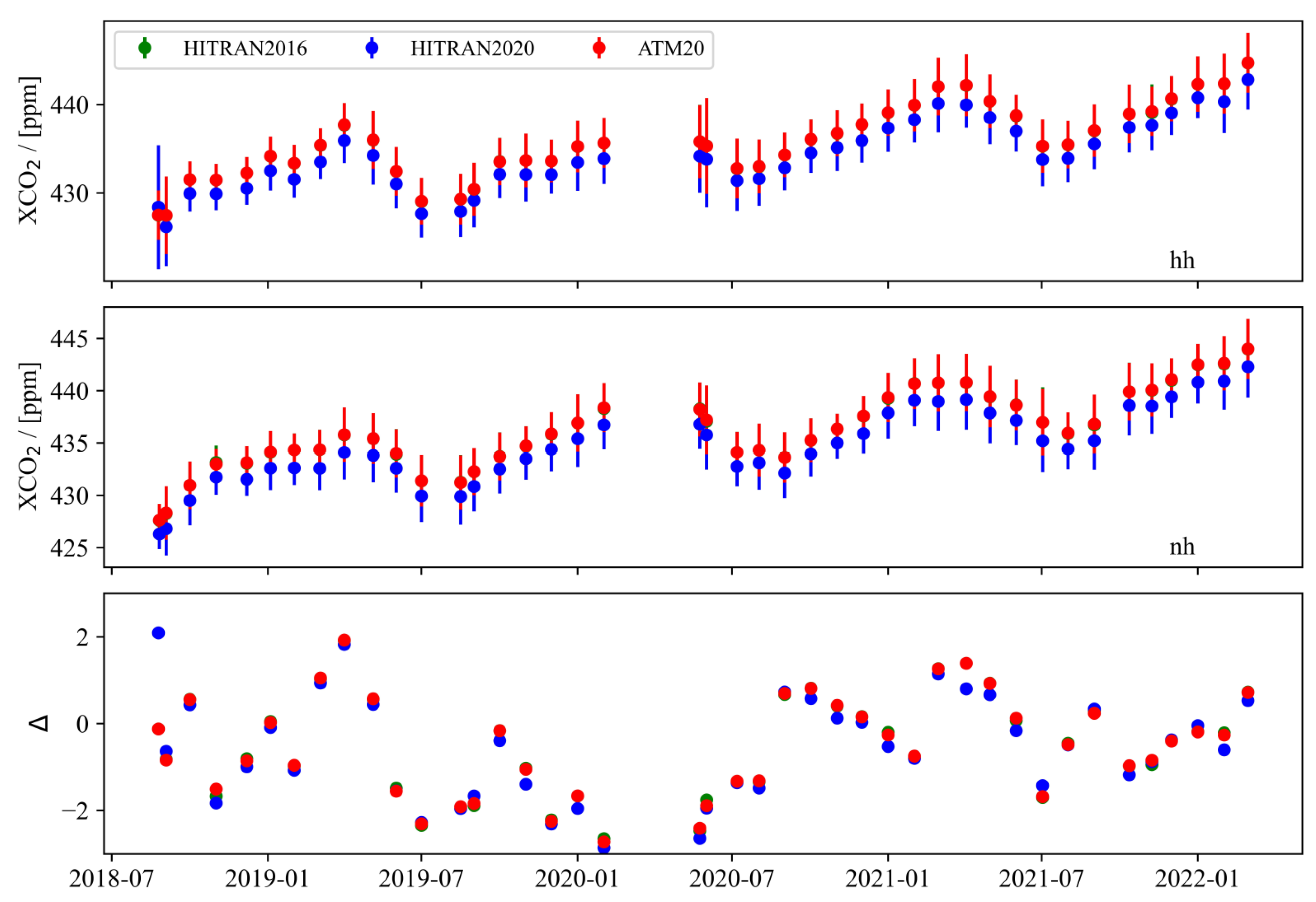


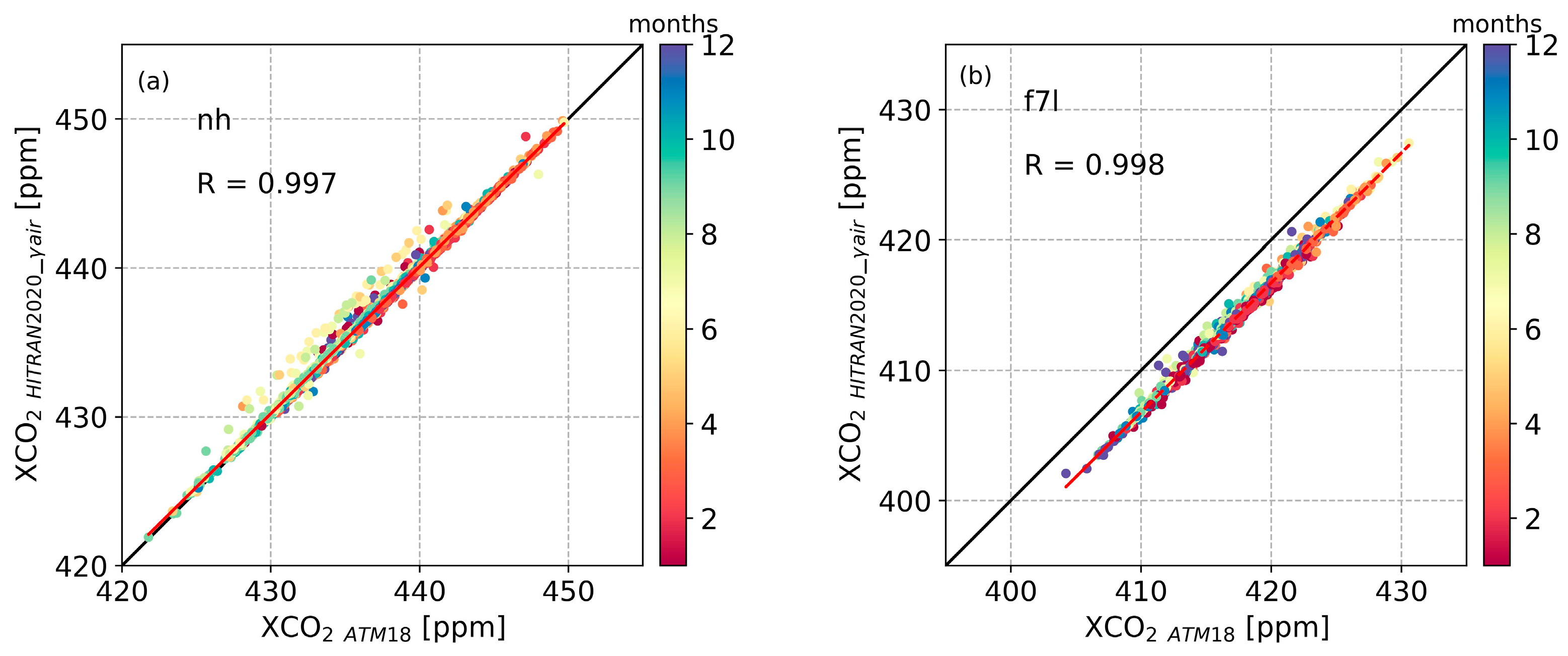
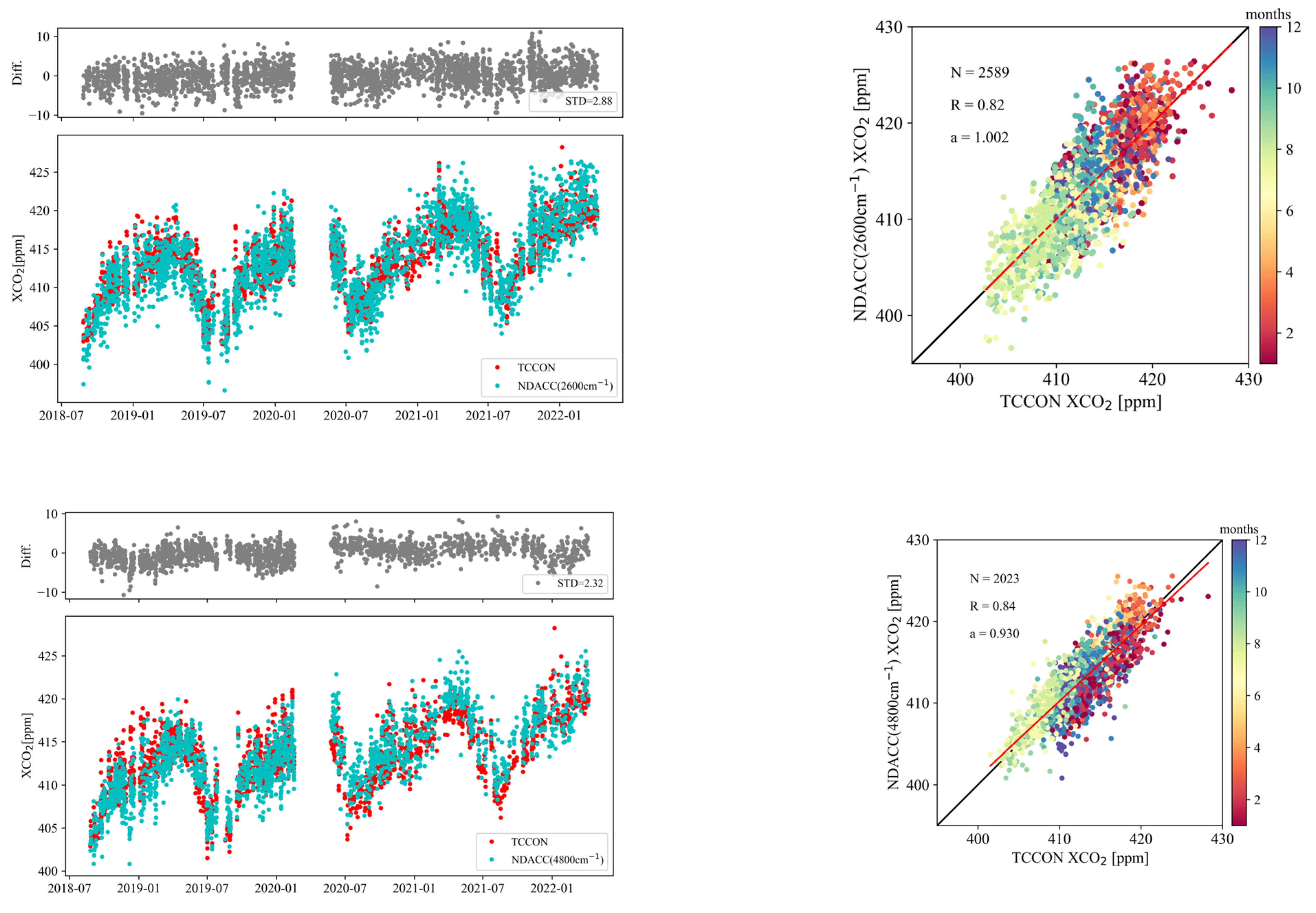

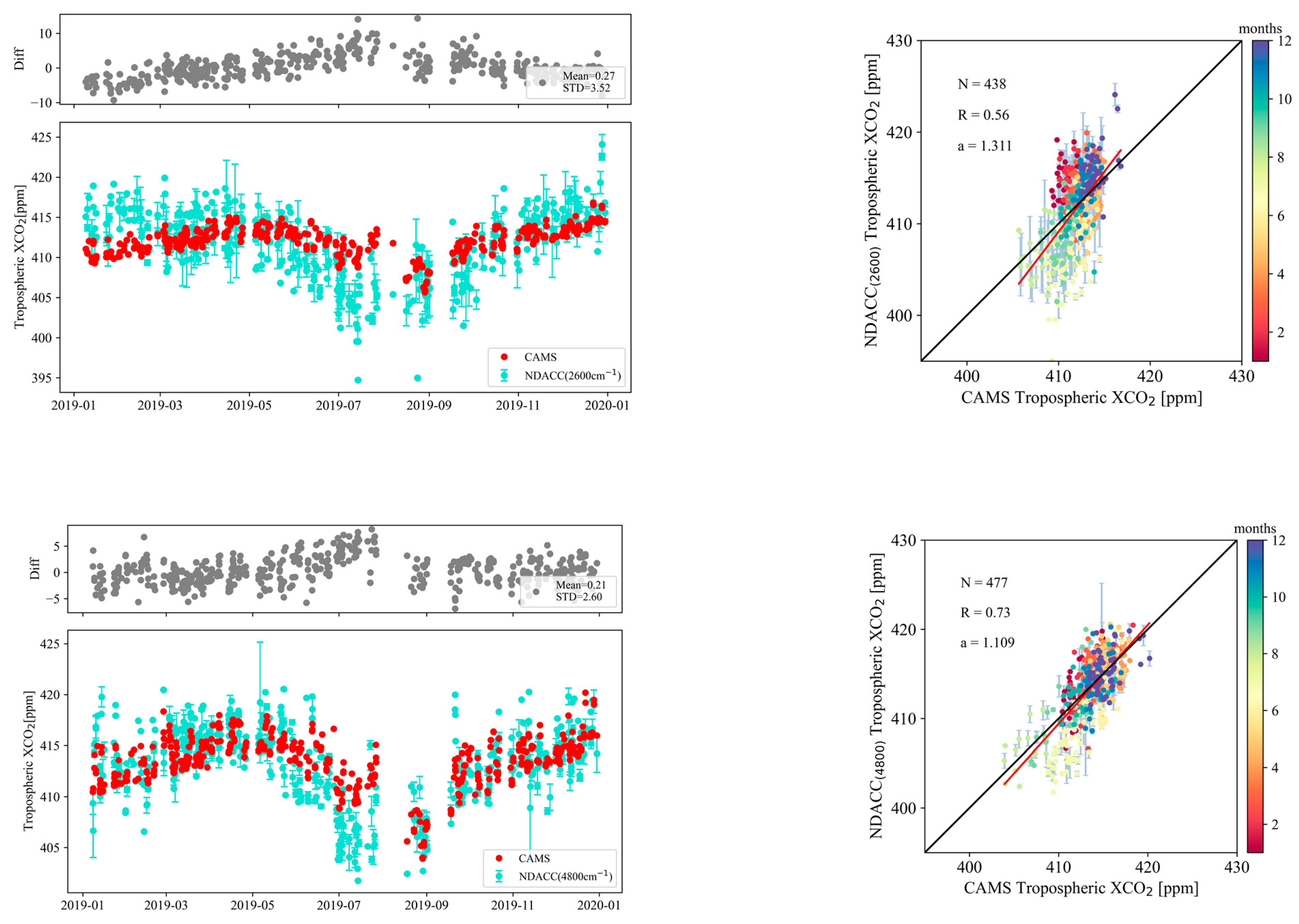
| Spectral Type | nh, hh | f7l |
|---|---|---|
| Retrieval windows (cm−1) | 2620.55–2621.10 | 4789.80–4790.50 |
| 2626.40–2626.85 | 4791.70–4792.10 | |
| 2627.10–2627.60 | 4795.10–4795.525 | |
| 2629.275–2629.950 | 4797.8–4798.25 | |
| Interfering gases | CH4, H2O, HDO, O3 | H2O, HDO, CH4, N2O |
| Regularization | Tikhonov (α = 1500) | Tikhonov (α = 2500) |
| T, P and H2O profiles | NCEP | |
| A priori profiles of retrieved species | WACCM v7 | |
| SNR | 400 | 250 |
| nh | f7l | |||||||
|---|---|---|---|---|---|---|---|---|
| α | 500 | 1500 | 2500 | 6000 | 500 | 1500 | 2500 | 6000 |
| XCO2 (ppm) | 430.64 ± 2.05 | 429.84 ± 1.18 | 430.15 ± 0.78 | 430.89 ± 0.88 | 403.01 ± 2.47 | 403.66 ± 1.90 | 403.63 ± 1.95 | 403.58 ± 1.72 |
| RMSE (%) | 0.095 ± 0.018 | 0.092 ± 0.020 | 0.092 ± 0.020 | 0.093 ± 0.020 | 0.144 ± 0.125 | 0.112 ± 0.053 | 0.092 ± 0.017 | 0.095 ± 0.016 |
| DOF | 2.27 ± 0.19 | 1.89 ± 0.16 | 1.72 ± 0.16 | 1.45 ± 0.13 | 3.20 ± 0.16 | 2.76 ± 0.11 | 2.55 ± 0.11 | 2.18 ± 0.10 |
| Spectroscopic Database | XCO2 (ppm) | RMSE (%) | DOF | ||||||
|---|---|---|---|---|---|---|---|---|---|
| nh | hh | f7l | nh | hh | f7l | nh | hh | f7l | |
| ATM18 | 436.58 | 436.38 | 416.92 | 0.125 | 0.143 | 0.154 | 1.97 | 1.93 | 2.60 |
| ATM20 | 436.60 | 436.40 | 416.92 | 0.125 | 0.143 | 0.154 | 1.97 | 1.93 | 2.60 |
| HITRAN2016 | 436.58 | 436.38 | 414.87 | 0.125 | 0.143 | 0.181 | 1.97 | 1.93 | 2.63 |
| HITRAN2020 | 435.07 | 434.75 | 408.97 | 0.124 | 0.142 | 0.129 | 1.97 | 1.94 | 2.60 |
Disclaimer/Publisher’s Note: The statements, opinions and data contained in all publications are solely those of the individual author(s) and contributor(s) and not of MDPI and/or the editor(s). MDPI and/or the editor(s) disclaim responsibility for any injury to people or property resulting from any ideas, methods, instructions or products referred to in the content. |
© 2024 by the authors. Licensee MDPI, Basel, Switzerland. This article is an open access article distributed under the terms and conditions of the Creative Commons Attribution (CC BY) license (https://creativecommons.org/licenses/by/4.0/).
Share and Cite
Wang, J.; Zhou, M.; Langerock, B.; Nan, W.; Wang, T.; Wang, P. Optimizing the Atmospheric CO2 Retrieval Based on the NDACC-Type FTIR Mid-Infrared Spectra at Xianghe, China. Remote Sens. 2024, 16, 900. https://doi.org/10.3390/rs16050900
Wang J, Zhou M, Langerock B, Nan W, Wang T, Wang P. Optimizing the Atmospheric CO2 Retrieval Based on the NDACC-Type FTIR Mid-Infrared Spectra at Xianghe, China. Remote Sensing. 2024; 16(5):900. https://doi.org/10.3390/rs16050900
Chicago/Turabian StyleWang, Jiaxin, Minqiang Zhou, Bavo Langerock, Weidong Nan, Ting Wang, and Pucai Wang. 2024. "Optimizing the Atmospheric CO2 Retrieval Based on the NDACC-Type FTIR Mid-Infrared Spectra at Xianghe, China" Remote Sensing 16, no. 5: 900. https://doi.org/10.3390/rs16050900
APA StyleWang, J., Zhou, M., Langerock, B., Nan, W., Wang, T., & Wang, P. (2024). Optimizing the Atmospheric CO2 Retrieval Based on the NDACC-Type FTIR Mid-Infrared Spectra at Xianghe, China. Remote Sensing, 16(5), 900. https://doi.org/10.3390/rs16050900





